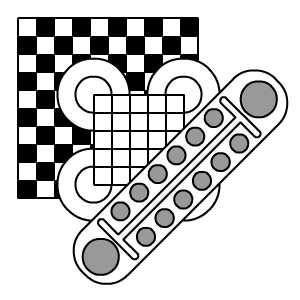
Barcelona 2002 Colloquium
| Journal |
| Colloquia |
| Who we are |
| Friend sites |
| Research notes |
| Search |

Board Games in Academia VAbstractsXavi BonetMaking wood games In Catalonia the national Curriculum for Secondary Education (12-16)
allows pupils to choose certain courses of study. At Guinards School, in
Barcelona, an optional course of study called 'Making Wood Games' is being
taken since 1.999. It combines a part of the 'Design & Technology'
curriculum with board games from around the world. In fact, technology makes
the perfect excuse to play board games.
In Catalonia the national Curriculum for Secondary Education (12-16)
allows pupils to choose certain courses of study. At Guinards School, in
Barcelona, an optional course of study called 'Making Wood Games' is being
taken since 1.999. It combines a part of the 'Design & Technology'
curriculum with board games from around the world. In fact, technology makes
the perfect excuse to play board games.
The main approach followed in the classroom is divided into four phases: firstly, pupils learn a set of 10 board games. In order to achieve this, they become experts on two of them that will be taught later on to the other classmates in small groups. As a result, they know how to play the ten board games. The second phase consists in playing all these games in order to enjoy and deepen their understanding of them. Thirdly, they should reflect on the games. At the beginning, they pick up some features or patterns such as the aim of the game, the board type (reticular, linear or areal) or the way pieces move. After that, they try to solve some challenging questions by playing repeatedly some of the games. Finally, students are requested to create new games through making alterations or combining characteristics of the ones they have previously learnt. Some conclusions have arisen from this experience. Curiously, pupils felt deep fascination by solitaires such as Pentalfa or Triple Exchange. Solitaires constitute a challenge because students play against themselves rather than a competition. You should not wait for your turn and can develop your own strategy without being disturbed by an opponent. As far as their knowledge of games is concerned, most of them didn't know anything about Chess and had scarcely played Draughts, Ludo and Three Men's Morris. They were spontaneously fond of games such as Jungle (Do Shou Qi) or Surakarta. Therefore, those games were their favourites when they had to build a game with wood. At first, almost all of them created hazard games usually played with dice. Perhaps they preferred hazard to strategy, as it was more convenient for them. Furthermore, when creating a non-hazard game, they were not worried about its 'playability'. Nevertheless, they realised that some games such as Nimbi or Pong Hau Qi were predictable and, consequently, they were not strictly 'playable' and had some limitations. In some cases new games were slightly different from the original ones, whereas in other cases they only had little resemblance. Finally, it was difficult to check if they had understood all the rules due to the learning method explained above.
|
[ Home Page | Journal | Colloquia | Who we are | Friend Sites | Research Notes | Search ]
